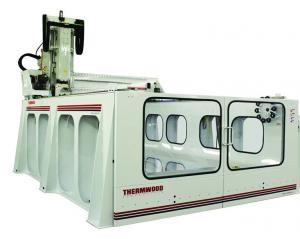Thermwood developed the first commercial CNC tool back in the 1970s, and offers three- and five-axis CNC machining centers used for production, fabrication, and trimming of materials like wood, plastics, and composites. In 2015, they decided to join the additive manufacturing world, and partnered with American Kuhne to develop a custom machine that could perform both additive and subtractive manufacturing, based on the original Thermwood Model 77, their giant, enclosed gantry machine. They announced their line of dual-gantry, high-wall LSAM systems back in September, which 3D print industrial tooling, molds, patterns, and fixtures for several industries, using reinforced thermoplastic composite materials. The dual gantries consolidate both printing and machining to the same system.
The LSAM machines are available in sizes up to 100 feet long, with print capability from 150 to 500 lbs an hour, and utilize a “near-net-shape” to make parts. The parts are 3D printed to a slightly larger than necessary size at high speeds, and later trimmed to their ultimate net size and shape. Just like the dual gantries keep printing and machining to the same machine, dual controls on the LSAM allow printing and trimming operations to be performed at the same time, on opposite ends of the table.
Thermwood upped their game and simplified their production even further last month, by adding real-time thermographic imaging to the LSAM systems, so they are able to produce large tools that are solid and void-free enough to maintain a vacuum without surface coating or sealing. The company has been in a prolonged R&D program to further develop their additive manufacturing equipment and technology, which is where FRC East, located at the Marine Corps Air Station Cherry Point in North Carolina, comes in.
Thermwood founder, CEO, and chairman Ken Susnjara said, “We are excited to work with the FRC East and are confident that, working together, we can achieve significant advances and results. I am confident that this program will benefit us both while further advancing the state of the art.”
